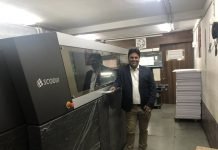ScanLab GmbH, an OEM scan solution producer, is unveiling a new additive-manufacturing scan head at Germany’s formnext 2019 tradeshow in Frankfurt. ScanLab used its 3D printing knowledge into fiberSYS so that sector newcomers, too, can use this all-in-one solution to quickly and easily create laser systems and scalable machine designs. The compact scan system optimizes machine assembly times for integrators and fabrication process times for users.
The 3D printing sector has been utilizing multi-head machines for many years. Productivity for large-area workpieces, in particular, can be significantly enhanced by combining multiple scan systems with high-overlap image fields. The new system was developed with this key relationship in mind. Its exterior dimensions and beam exit location are optimized to facilitate maximum overlap between adjacent scanners.
ScanLab know-how of laser beam positioning for additive manufacturing has been applied to the new fiberSYS as a turn-key system solution that simplifies machine construction. Machine builders can now concentrate completely on laser processes, without being burdened by their tool’s optomechanical design complexities.
The new scan system is configured for control via an RTC board, and for deflection of multi-KW single-mode fiber lasers. The sealed dust-proof scan head features a fiber adapter for direct connection of the laser, as well as a process monitoring interface. Ultra-low-drift galvos with digital encoders are regulated via the newest generation of servo electronics. In combination with its optimally designed mirrors, the system delivers high imaging quality and dynamic performance. Its pre-focus configuration with integrated z-axis enables scan head usage without an F-Theta objective, thus reducing thermal drift.
The new metal-based additive manufacturing scan solution can be ordered starting Q2 2020. ScanLab will issue design recommendations for optimal usage of multiple scan heads, but this is also an open, modular system platform flexibly adaptable to customer-specific requirements.


















